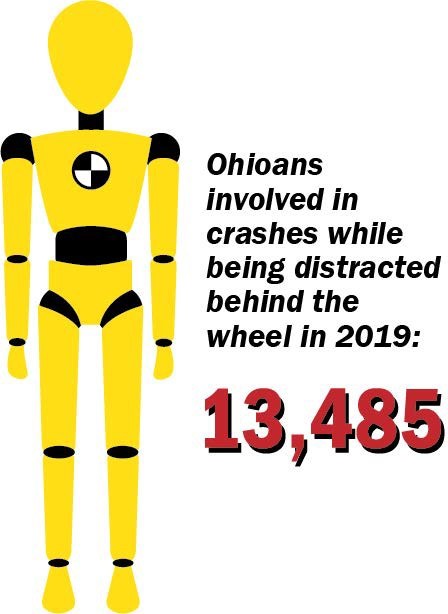Distracted Driving Law
Phones Down. It's the Law.
As of April 4, 2023, Ohio law makes distracted driving a primary traffic offense and drivers can be immediately pulled over for violating the law.
The following actions are prohibited:
- Dialing a phone number
- Sending a text message
- Scrolling or updating social media account
- Watching videos or taking FaceTime calls
- Browsing the Internet
- Playing games
- Recording or streaming video
Drivers over the age of 18 can make or receive calls using hands-free technology such as speakerphone, earpiece, wireless headset, Bluetooth, electronic watch or connecting a phone to a vehicle. Drivers can also listen to audio streaming apps and use navigation if they turn them on before getting on the road or use a single swipe touch to activate, modify or deactivate the app or navigation equipment.
It is still illegal for drivers under the age of 18 to use an electronic device in any way while driving, including hands-free features.
There are some exceptions to the new law, including:
- Drivers reporting an emergency to law enforcement, a hospital, health care provider, fire department, or similar emergency entity.
- Drivers holding a phone to their ear only during phone conversations, if the call is started or stopped with a single touch or swipe.
- Drivers holding or using cell phones and other electronic devices while stopped at a traffic light or parked on a road or highway during an emergency or road closure.
- First responders (law enforcement, fire, EMS), using electronic devices as part of their official duties.
- Utility workers operating utility vehicles in certain emergency or outage situations.
- Licensed operators using an amateur radio.
- Commercial truck drivers using a mobile data terminal.
Enforcement and Penalties
The following penalties will be issued for violations beginning Oct. 3, 2023:
- First offense in two years: 2 points assessed to driver's license, up to $150 fine
- Second offense in two years: 3 points assessed to driver's license, up to $250 fine
- Third or more offense in two years: 4 points assessed to driver's license, up to $500 fine, possible 90-day suspension of driver's license
- Fines double if the violation occurs in a work zone.
*Completion of a distracted driving course can help avoid the fine and points.
Distracted Driving a Priority for Governor DeWine
Enacting tougher distracted driving laws has been a top priority for Gov. DeWine, who has helped bring awareness to the importance of this issue and educate lawmakers about the need for stronger distracted driving laws in Ohio. On Jan. 3, 2023, Ohio Gov. Mike DeWine signed Senate Bill 288 (Manning) into law, making it a primary traffic offense to use a handheld electronic wireless communications device while driving.
"Right now, too many people are willing to risk their lives while behind the wheel to get a look at their phones," Gov. DeWine said during the bill signing. "My hope is that this legislation will prompt a cultural shift around distracted driving that normalizes the fact that distracted driving is dangerous, irresponsible and just as deadly as drunk driving."
The provisions in the original distracted driving bill, House Bill 283 (Abrams, Lampton), were added as an amendment to S.B. 288, Sen. Manning’s criminal justice reform bill during the final hours of the 134th General Assembly.
Traffic Fatalities Rising
Data from the Ohio State Highway Patrol indicates that traffic deaths rose by nearly 10% in 2021 - from 1,230 in 2020 to 1,351.
There were 11,910 distracted driving crashes in Ohio in 2021, up 8.2% from 11,006 in 2020.
Fatalities on Ohio’s roads have risen six of the past seven years. This rise is directly correlated to more people now having smartphones, leading to an increase in active distraction while behind the wheel.
The dangers of using a hand-held electronic device while driving include greater variability in speed, position within lane (i.e., weaving) and distance from car in front, and slower reaction times that increase the frequency and severity of collisions.
Distracted Driving's Deadly Toll on Pedestrians
Tragically, the number of motorists and pedestrians either injured or killed due to distracted driving has surged in the past three decades. Smartphones and other handheld electronic devices are known to be significant factors in these unfortunate and preventable accidents.
- During 2018 and 2019, pedestrian fatalities reached their highest in 30 years.
- Reported fatal crashes from distracted driving also nearly doubled since the early 1990s.
- In 2019, there were approximately 36,408 traffic fatalities nationwide, – 6,301 of which were pedestrians. That means pedestrians accounted for 17% of all traffic fatalities in 2019.
- During the height of the COVID-19 outbreak in 2020, pedestrian fatalities increased by 20%, and traffic fatalities remained consistent despite the 16.5% decrease in traffic volume throughout the year.
- Tragically, people of color have been shown to represent a disproportionate number of victims of pedestrian fatalities.

Distracted Driving is THE Biggest Concern for Ohio Drivers
According to a statewide poll commissioned by FOR Ohio and prepared by Neil Newhouse of Public Opinion Strategies, nearly half of Ohio drivers surveyed cited distracted driving as their biggest concern.
OII President Dean Fadel on Auto Smarts Radio
OII President Dean Fadel was a guest on Auto Smarts Radio where he discussed the dangers of distracted driving and the need for tougher distracted driving laws. Listen to his full interview below.
